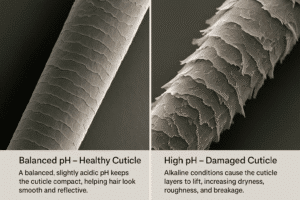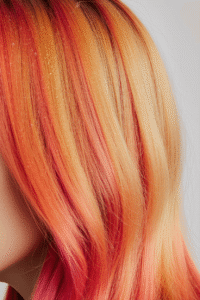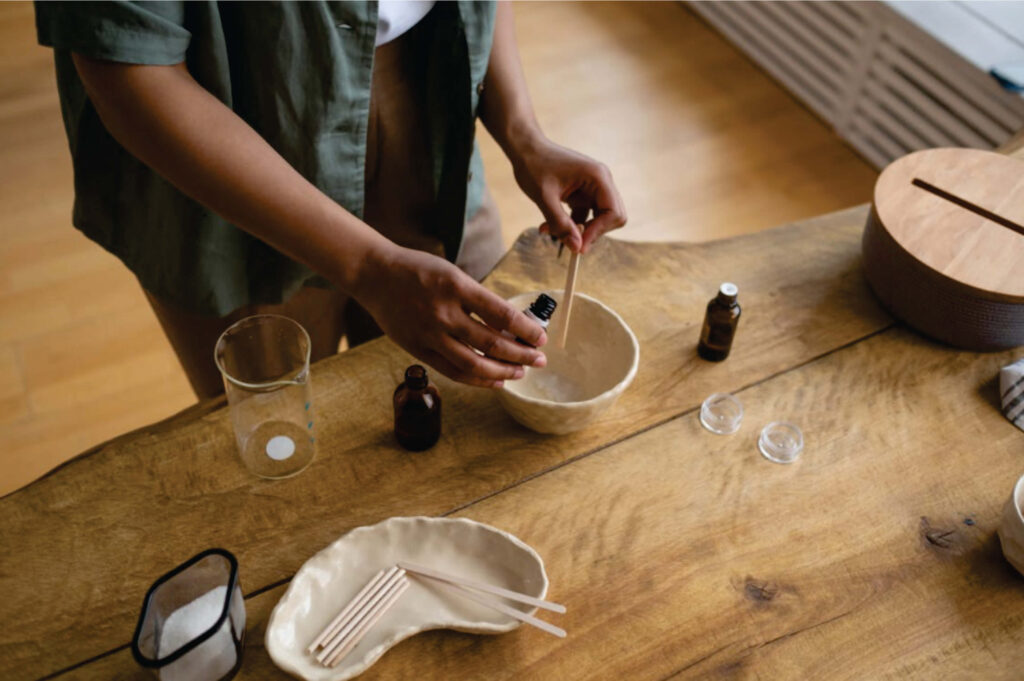Understanding pH balance in hair care is essential for maintaining healthy, vibrant hair. The pH level influences your hair’s structure, shine, strength, and moisture retention. Many people notice that some products leave their hair dull or tangled. The cause is often a disrupted pH level. When you understand how pH works, you gain the power to prevent dryness, frizz, and breakage. This expanded guide explores why pH matters, how to test it, and how to build a hair care routine that protects your scalp and cuticle.

What Is pH and Why Does It Matter in Hair Care?
The pH scale measures acidity or alkalinity from 0 to 14. A value of 7 is neutral. Anything below 7 is acidic, and anything above 7 is alkaline. Healthy hair has a natural pH between 4.5 and 5.5. This slightly acidic range keeps the cuticle flat. A smooth cuticle protects the inner structure of the hair, reduces moisture loss, and increases shine.
When the pH rises too high, the cuticle opens. Hair becomes rough, dry, and more prone to breakage. When the pH drops too low, products can cause buildup and reduce elasticity. Both extremes weaken the fiber and disrupt the natural pH balance in hair care.
A detailed study published in the International Journal of Trichology by Gavazzoni Dias et al. analyzed the pH of 123 shampoos from international brands. The authors found that only 38.21% of all shampoos had a pH of 5.5 or lower, while 61.78% were more alkaline. They also reported that 100% of children’s shampoos had a pH above 6.0 due to the “no-tear” formulation. The study concluded that alkaline shampoos increase the negative charge on the hair surface. This raises friction, encourages frizz, and leads to cuticle damage and breakage.
These findings show why maintaining a stable pH is essential. When the surface charge increases, fibers repel each other, and the cuticle becomes more vulnerable. This creates tangling, roughness, and mechanical damage during brushing.
A review article “Hair Cosmetics: An Overview” by Gavazzoni Dias explains that alkaline products and chemical treatments can cause hair shaft swelling and lift the cuticle scales. This makes the hair more hydrophilic, increases friction and frizz, and raises the risk of breakage. The same review notes that protective ingredients such as conditioners and oils help reduce water uptake, limit swelling, and keep the cuticle smoother.
How to Measure pH in Hair Products
Measuring pH does not require professional tools. You can get reliable results with simple methods:
1. pH Test Strips
These strips are inexpensive and work well for most liquids. Dip the strip into your shampoo or rinse. Compare the color change to the scale on the package.
2. Digital pH Meters
A meter gives a more precise reading. Many hair formulators use them to test ingredients. You can test diluted conditioners and masks as well.
3. Observing Hair Condition
We cannot measure the pH of the hair fiber directly. But we can use clues. If hair feels rough, tangled, or brittle, its pH may be disrupted. A scalp that becomes irritated after washing may also react to an alkaline product.
Most experts recommend products designed to match the natural pH of the scalp. Shampoos and conditioners with a value close to 4.5–5.5 support the cuticle. They also help prevent moisture loss.

Why pH Balance Is Essential for Hair Health
Healthy pH supports the structural integrity of each strand. When the cuticle stays closed, the cortex remains protected. This prevents swelling and reduces internal damage. A stable pH also creates more shine, because a smooth cuticle reflects light.
Several studies confirm this effect. A study published in the International Journal of Trichology (“The Shampoo pH can Affect the Hair: Myth or Reality?”, Gavazzoni Dias et al.) confirms that shampoos with a pH above 5.5 can irritate the scalp, increase friction, and weaken the hair fiber.
This highlights the importance of pH balance in hair care not only for beauty but also for scalp comfort.
Balancing Your Hair’s pH for Optimal Health
Maintaining a healthy pH is easier when you create a consistent routine. The steps below can help.
1. Choose pH-Balanced Products
Look for shampoos labeled as “pH-balanced.” Some brands list the exact value on the bottle. When they do not, you can test the product at home. A mild, sulfate-free shampoo usually has a lower pH and is gentler on the cuticle.
2. Use Acidic Rinses
Apple cider vinegar is one of the most popular acidic rinses. It has a pH between 2 and 3. When diluted, it helps restore balance, remove residue, and smooth the cuticle. Mix one part vinegar with two parts water.
A detailed review from Healthline explains that apple cider vinegar has a naturally low pH of around 2–3 and may help restore acidity when used in diluted form. The article also notes that ACV shows antibacterial and antifungal properties, which may support scalp health. However, the authors emphasize that scientific evidence for its direct effects on hair pH and structure is limited.
3. Avoid Harsh Alkaline Ingredients
Baking soda has a pH around 9. Many blogs suggest using it as a clarifying treatment, but research shows that its high pH can damage the hair’s surface. An analysis published in the International Journal of Trichology demonstrates that alkaline products significantly increase the negative surface charge of the hair fiber. This raised charge increases friction, lifts the cuticle, and makes strands more vulnerable to breakage. Because baking soda is strongly alkaline, it follows the same damaging mechanism described in the study.
4. Deep Condition Regularly
Deep conditioners help close the cuticle. Weekly treatments can increase softness and hydration. They also reduce damage from heat styling and color.
Common Hair Issues Caused by pH Imbalance
When pH levels shift outside the healthy range, many problems appear. Here are some frequent signs:
Dryness and Frizz
A high pH opens the cuticle, allowing moisture to escape more easily. When the cuticle stays lifted, hair loses hydration faster and becomes frizzy. Alkaline products can also disrupt the natural oil layer that protects each strand. As a result, hair feels rougher, tangles more quickly, and is more prone to breakage. Keeping products within a healthy pH range helps the cuticle lie flat, which supports smoothness and reduces frizz.
Breakage
When the fiber swells from alkaline exposure, weak points appear. These areas snap during brushing or washing.
Scalp Irritation
A disturbed pH weakens the protective barrier of the scalp. This may lead to itching, flakes, or redness.
Dullness
Shine comes from a smooth surface. Without proper pH, the cuticle lifts and scatters light. Hair loses glow and looks tired.
These issues highlight why pH balance in hair care is important for both appearance and resilience.
Tips for Supporting pH Balance
You can keep your hair in a healthy range with simple daily habits:
- Rinse with cool water to help close the cuticle.
- Use color-safe products, as they often have a mild acidic base.
- Follow chemical treatments with pH-restoring masks.
- Choose natural ingredients that support balance, such as aloe vera or honey.
- Test your products every few months if your routine changes.
Personal Stories and Community Insights
Many people on beauty forums discuss pH-related struggles. Their stories show how common these issues are.
Story 1: The High-pH Shampoo Problem
One user on Reddit’s r/HaircareScience shared her experience. She used a clarifying shampoo with a pH around 8 every wash. At first her hair felt clean. Later it became dry and brittle. She described how her curls lost shape and felt rough. When she switched to a pH-balanced shampoo and added an acidic rinse, her hair improved within two weeks. She wrote that her curls “finally felt alive again.”
Story 2: Hard Water and pH
Another member wrote that she lived in an area with hard water. Her products should have worked, but her hair still looked dull. After testing her water, she learned that it was alkaline. She installed a shower filter. She also added a weekly acidic rinse. The combination restored shine and softness. Several users confirmed the same experience.
Story 3: Bleached Hair and pH Damage
A woman who bleached her hair often described severe irritation and breakage. Her stylist explained that bleach raises the pH significantly. He recommended protein treatments and acidic masks. She followed this advice. Her scalp calmed down, and her hair regained strength after several weeks.
These real experiences highlight how pH balance in hair care can transform hair health when people understand the science behind it.
How pH Works with Hair Porosity
Porosity indicates how easily your hair absorbs moisture. Low-porosity hair has a tight cuticle. High-porosity hair has gaps or lifted scales.
pH has a strong effect here:
- Acidic formulas help low-porosity hair accept moisture.
- Acidic rinses help high-porosity hair seal the cuticle.
- Alkaline products increase porosity temporarily, which can be harmful when used often.
Knowing this helps you choose the right treatments for your hair type.
The Science Behind pH and Hair Color

Color-treated hair is especially sensitive to pH changes. Bleaching and permanent dyes raise the pH sharply to lift the cuticle and allow pigments to enter the cortex. If the cuticle stays open after coloring, moisture escapes more easily and color fades faster.
A review published in Hair Cosmetics: An Overview (Gavazzoni Dias, 2015) explains that acidic treatments help reduce fiber swelling and bring the cuticle back toward a closed position after alkaline chemical services. A smoother, sealed cuticle supports better color retention and reduces breakage.
This is why salons often use acidic post-color rinses — they help restore the hair’s natural acidity and protect the new color.
Building a Routine That Supports Healthy pH
If you want long-term results, structure your routine with pH awareness in mind:
- Use a mild shampoo twice a week.
- Condition after every wash.
- Add a deep mask once a week.
- Use an acidic rinse every 10–14 days.
- Avoid alkaline DIY treatments.
- Test your products when your hair changes due to climate or chemical services.
When you follow these steps, you maintain consistent pH balance in hair care, which supports softness, shine, and strength.
Conclusion
The role of pH in hair care is more significant than most people realize. It affects moisture, elasticity, shine, and even scalp comfort. When you understand how pH works, you can make better choices. You can prevent common problems and protect your hair from long-term damage.
By focusing on pH balance in hair care, you can maintain a smooth cuticle and a healthy scalp. With the right routine, tools, and products, your hair becomes more resilient and vibrant. The science is clear. Balanced pH leads to stronger, shinier, and healthier hair.
How to Choose the Right Ingredients for Hair Care: A Guide to Oils, Proteins, and Plant Extracts
The Economics of DIY Haircare: Comparing the Costs of DIY and Professional Products

I’m Victoria, the creator behind Eva My Balance. Passionate about beauty, wellness, sustainable living, and mindful self-care. My mission is to inspire you to live consciously and beautifully—inside and out.


